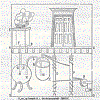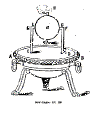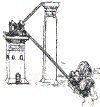 |
|
||
|---|---|---|---|
 |
 A PEEP INTO HISTORY A PEEP INTO HISTORYPower of Steam - What was invented first ? The Gauge,- Who invented steam locomotive ? The rainhill trial, Progress of Railway revolution, Prejudice and opposition |
 BHOLU THE GUARD |
|
|
Some
earliest steam powered engines claimed to be used in ancient times. |
POWER OF
STEAM
(This page was last modified on
08/05/08 ) (FRANCE) In 1641 Marion de Lorme and the Marquis of Worcester visited together one of the Paris madhouses. Looking through the bars of his cell was a man named Solomon de Cause. "I am not mad," he cried to the visitors, "I am not mad! But I have made a discovery that would enrich the country that would adopt it. But I am not mad. I am not mad." "The poor creature says that he has discovered a wonderful power in the use of steam from boiling water," explained the keeper. "He came from Normandy, about four years ago, to present to the king a statement of the wonderful effects that might be produced from his invention. Cardinal Richelieu sent him away without listening to him. Solomon persisted, and, following the cardinal wherever be went, finally so annoyed him with his discovery that he had him shut up in the Bicetre as a madman." The Marquis of Worcester, not being dependent upon Richelieu, went back to England to work at the same problem that had cost Solomon de Cause his liberty. He succeeded so well that in 1656 he erected in London a machine which "raised water more than forty feet by the power of one man only." What the machine was used for, or if it was used for anything, we are not told.
After this, however, progress
was more rapid, and in 1718 steam was for the first time put into industrial
harness by a Cornish miner named Savary, who built an engine to pump water from
the mines. Forty seven years later in 1765 - James Watt constructed
his first steam engine at the Corson Iron Works, Glasgow, Scotland and the steam age began. |
||
 Even in early 16th Century, in England there were metalled tracks for horse-hauled trucks 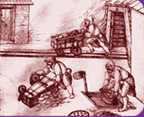 Miners' hand cart 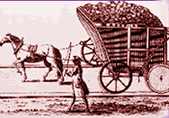 mining wagons on wooden wagonways |
What was invented first ? The Railways or the Steam Engine ? Though even before the age of steam engines, i.e., even in early 16th Century, in England there were metalled( built with stone linings) tracks for horse-hauled trucks, the earliest is in 1630 - when a man named Beaumont laid rails on a highway in England to transport coal from the Newcastle mines. This is the first railroad known in history.Strictly speaking , the history of Railways goes back much further in time. Traces of evidence are still available which establish that in devastated Pompeii, ancient Greece and even in the Middle-East, "rutways" in stone paving were in existence several centuries earlier, for facilitating haulage of wagons and chariots. According to another opinion Roads of rails called Wagonways were being used in Germany as early as 1550. These primitive railed roads consisted of wooden rails over which horse-drawn wagons or carts moved with greater ease than over dirt roads. Wagonways were the beginnings of modern railroads. By 1776, iron had replaced the wood in the rails and wheels on the carts. Wagonways evolved into Tramways and spread though out Europe. Horses still provided all the pulling power. In 1789, Englishman, William Jessup designed the first wagons with flanged wheels. The flange was a groove that allowed the wheels to better grip the rail, this was an important design that carried over to later locomotives. |
||
|
THE GAUGE
When George Stephenson
was building the Stockton & Darlington Railway
he decided the rail gauge should be just over 4 ft 8 ins (1.44m). The reason
for this was that was the width of the "wagon way" at Killingworth Colliery.
However, after Stephenson had made this decision, other railway chief
engineers followed his example and used the same rail gauge. |
|||
|
But according to a different
opinion |
|||
|
|
|||
|
The author of
the page acknowledges help from old Eastern Railway Magazines IR magazines and
from steam loco web pages and a lot many books and articles on the
subject. Interested to read more such stories and know more on this subject
steam engines? Must visit
http://www.history.rochester.edu/steam |
|||
|
Please post your comments mreenaldas@yahoo.co.in |
THANK YOU FOR VISITING THIS PAGE |
||
